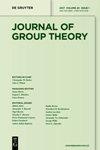Twisted conjugacy in residually finite groups of finite Prüfer rank
IF 0.5
3区 数学
Q4 MATHEMATICS
引用次数: 0
Abstract
Suppose 𝐺 is a residually finite group of finite upper rank admitting an automorphism 𝜑 with finite Reidemeister number有限普吕弗秩的残余有限群中的扭曲共轭
假设𝐺是一个有限上秩的残余有限群,它容许一个具有有限雷德梅斯特数 R ( φ ) R(\varphi)(𝜑扭曲共轭类的数)的自形𝜑。我们证明,这样的𝐺是可逐无限溶的(换句话说,任何不具有可逐无限溶性的有限上秩的残余有限群都具有 R ∞ R_{infty} 性质)。这一还原是本文第二个主要定理证明的第一步:假设𝐺 是一个有限普吕费秩的残余有限群,𝜑 是它的自变量。那么 R ( φ ) R(\varphi)(如果它是有限的)等于𝐺 的有限维不可还原单元表示的等价类的数量,这些等价类是对偶映射 φ ̂ : [ ρ ] ↦ [ ρ ∘ φ ] \hat{\varphi}\colon[\rho]\mapsto[\rho\circ\varphi] 的定点(即,我们证明了 TBFT 的等价类的数量)。也就是说,我们为这类群证明了 TBFT𝑓,即关于扭曲伯恩赛德-弗罗贝尼斯定理的猜想的有限版本)。
本文章由计算机程序翻译,如有差异,请以英文原文为准。
求助全文
约1分钟内获得全文
求助全文
来源期刊

Journal of Group Theory
数学-数学
CiteScore
1.00
自引率
0.00%
发文量
45
审稿时长
6 months
期刊介绍:
The Journal of Group Theory is devoted to the publication of original research articles in all aspects of group theory. Articles concerning applications of group theory and articles from research areas which have a significant impact on group theory will also be considered.
Topics:
Group Theory-
Representation Theory of Groups-
Computational Aspects of Group Theory-
Combinatorics and Graph Theory-
Algebra and Number Theory
 求助内容:
求助内容: 应助结果提醒方式:
应助结果提醒方式:


